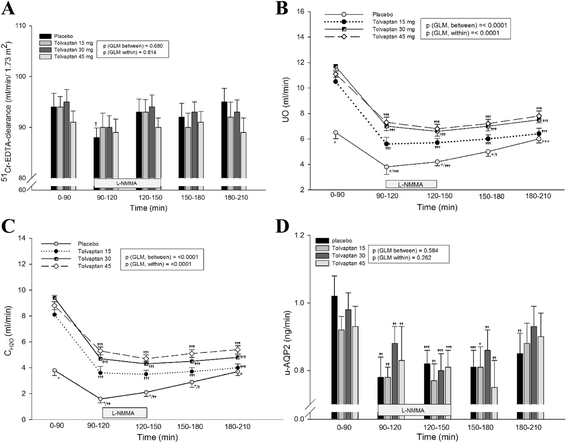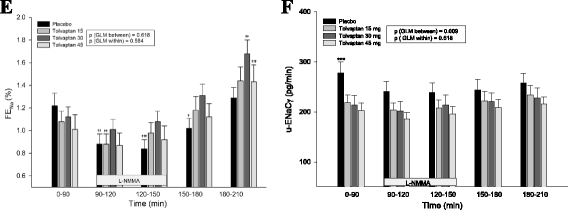Effect of tolvaptan on renal water and sodium excretion and blood pressure during nitric oxide inhibition: a dose-response study in healthy subjects
- PMID: 28288570
- PMCID: PMC5347830
- DOI: 10.1186/s12882-017-0501-1
Effect of tolvaptan on renal water and sodium excretion and blood pressure during nitric oxide inhibition: a dose-response study in healthy subjects
Abstract
Background: Tolvaptan is a selective vasopressin receptor antagonist. Nitric Oxide (NO) promotes renal water and sodium excretion, but the effect is unknown in the nephron's principal cells. In a dose-response study, we measured the effect of tolvaptan on renal handling of water and sodium and systemic hemodynamics, during baseline and NO-inhibition with L-NMMA (L-NG-monomethyl-arginine).
Methods: In a randomized, placebo-controlled, double blind, cross over study, 15 healthy subjects received tolvaptan 15, 30 and 45 mg or placebo. L-NMMA was given as a bolus followed by continuous infusion during 60 min. We measured urine output (UO), free water clearance (CH2O), fractional excretion of sodium (FENa), urinary aquaporin-2 channels (u-AQP2) and epithelial sodium channels (u-ENaCγ), plasma vasopressin (p-AVP) and central blood pressure (cBP).
Results: During baseline, FENa was unchanged. Tolvaptan decreased u-ENaCγ dose-dependently and increased p-AVP threefold, whereas u-AQP2 was unchanged. During tolvaptan with NO-inhibition, UO and CH2O decreased dose-dependently. FENa decreased dose-independently and u-ENaCγ remained unchanged. Central BP increased equally after all treatments.
Conclusions: During baseline, fractional excretion of sodium was unchanged. During tolvaptan with NO-inhibition, renal water excretion was reduced dose dependently, and renal sodium excretion was reduced unrelated to the dose, partly via an AVP dependent mechanism. Thus, tolvaptan antagonized the reduction in renal water and sodium excretion during NO-inhibition. Most likely, the lack of decrease in AQP2 excretion by tolvaptan could be attributed to a counteracting effect of the high level of p-AVP.
Trial registration: Clinical Trial no: NCT02078973 . Registered 1 March 2014.
Keywords: AQP2; Blood pressure; ENaC; Nitric oxide; Tolvaptan; Vasoactive hormones.
Figures



Similar articles
-
Effect of tolvaptan on renal handling of water and sodium, GFR and central hemodynamics in autosomal dominant polycystic kidney disease during inhibition of the nitric oxide system: a randomized, placebo-controlled, double blind, crossover study.BMC Nephrol. 2017 Aug 15;18(1):268. doi: 10.1186/s12882-017-0686-3. BMC Nephrol. 2017. PMID: 28810844 Free PMC article. Clinical Trial.
-
Effect of vasopressin antagonism on renal handling of sodium and water and central and brachial blood pressure during inhibition of the nitric oxide system in healthy subjects.BMC Nephrol. 2014 Jun 25;15:100. doi: 10.1186/1471-2369-15-100. BMC Nephrol. 2014. PMID: 24965902 Free PMC article. Clinical Trial.
-
Effect of nebivolol on renal nitric oxide availability and tubular function in patients with essential hypertension.Br J Clin Pharmacol. 2015 Sep;80(3):425-35. doi: 10.1111/bcp.12627. Epub 2015 Jun 5. Br J Clin Pharmacol. 2015. PMID: 25778445 Free PMC article. Clinical Trial.
-
Regulation of renal sodium and water excretion in the nephrotic syndrome and cirrhosis of the liver.Dan Med Bull. 1997 Apr;44(2):191-207. Dan Med Bull. 1997. PMID: 9151012 Review.
-
Pathophysiology of renal fluid retention.Kidney Int Suppl. 1998 Sep;67:S127-32. doi: 10.1046/j.1523-1755.1998.06724.x. Kidney Int Suppl. 1998. PMID: 9736267 Review.
Cited by
-
Effect of tolvaptan on renal handling of water and sodium, GFR and central hemodynamics in autosomal dominant polycystic kidney disease during inhibition of the nitric oxide system: a randomized, placebo-controlled, double blind, crossover study.BMC Nephrol. 2017 Aug 15;18(1):268. doi: 10.1186/s12882-017-0686-3. BMC Nephrol. 2017. PMID: 28810844 Free PMC article. Clinical Trial.
-
Effects of Nondipping Blood Pressure Changes: A Nephrologist Prospect.Cureus. 2023 Jul 30;15(7):e42681. doi: 10.7759/cureus.42681. eCollection 2023 Jul. Cureus. 2023. PMID: 37649932 Free PMC article. Review.
-
Identifying the main predictors of urine output in autosomal-dominant polycystic kidney disease (ADPKD) patients taking tolvaptan.Int Urol Nephrol. 2023 Oct;55(10):2629-2637. doi: 10.1007/s11255-023-03555-8. Epub 2023 Mar 23. Int Urol Nephrol. 2023. PMID: 36952108
-
RNA-Seq-Based Transcriptome Analysis of Chinese Cordyceps Aqueous Extracts Protective Effect against Adriamycin-Induced mpc5 Cell Injury.Int J Mol Sci. 2024 Sep 26;25(19):10352. doi: 10.3390/ijms251910352. Int J Mol Sci. 2024. PMID: 39408685 Free PMC article.
-
Molecular Interaction Between Vasopressin and Insulin in Regulation of Metabolism: Impact on Cardiovascular and Metabolic Diseases.Int J Mol Sci. 2024 Dec 11;25(24):13307. doi: 10.3390/ijms252413307. Int J Mol Sci. 2024. PMID: 39769071 Free PMC article. Review.
References
-
- Nielsen S, Kwon TH, Christensen BM, Promeneur D, Frokiaer J, Marples D. Physiology and pathophysiology of renal aquaporins. J Am Soc Nephrol. 1999;10:647–63. - PubMed
Publication types
MeSH terms
Substances
Associated data
LinkOut - more resources
Full Text Sources
Other Literature Sources
Medical
Miscellaneous

